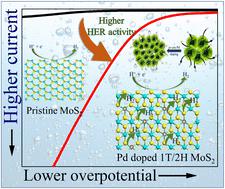当前位置:
X-MOL 学术
›
Sustain. Energy Fuels
›
论文详情
Our official English website, www.x-mol.net, welcomes your feedback! (Note: you will need to create a separate account there.)
In situ Pd-doped MoS2 nanosheets as an HER electrocatalyst for enhanced electrocatalytic water splitting
Sustainable Energy & Fuels ( IF 5.6 ) Pub Date : 2024-02-19 , DOI: 10.1039/d3se01459b Jyoti Gupta 1, 2 , Dibakar Das 2 , Pramod H. Borse 1 , B. V. Sarada 1
Sustainable Energy & Fuels ( IF 5.6 ) Pub Date : 2024-02-19 , DOI: 10.1039/d3se01459b Jyoti Gupta 1, 2 , Dibakar Das 2 , Pramod H. Borse 1 , B. V. Sarada 1
Affiliation

|
Developing highly active, stable, and economic electrocatalysts for sustainable hydrogen (H2) production is crucial for efficient water electrolysis. In this study, a highly effective and affordable electrocatalyst for hydrogen evolution was developed using an easy and straightforward one-step hydrothermal method for in situ doping of Pd into the lattice of MoS2. The physico-chemical and electrochemical properties of the as-prepared Pd-doped MoS2 systems were thoroughly studied. After Pd was doped into the MoS2 lattice, sulfur vacancies were induced, which led to a phase change from the semiconducting (2H) to the metallic (1T) phase of MoS2. These changes altered the material's morphology and optimized its electronic structure, making it a superior electrocatalyst for water splitting. The electrocatalytic activity of a cathode prepared via drop-casting using Pd–MoS2 nanostructured powder for HER applications was studied in acidic water, alkaline water, and simulated sea water. In order to attain a current density of 10 mA cm−2 during HER application, nanostructured Pd–MoS2 exhibited greater electrocatalytic activity in acidic conditions with an overpotential of only 89 mV vs. RHE (acidic) compared to 149 mV vs. RHE (alkaline) and 165 mV vs. RHE (simulated sea water). Moreover, in acidic, alkaline, and simulated sea water, Pd–MoS2 demonstrated superior activity during electrocatalytic water splitting and low cell potentials of +1.98, +2.03, and +2.18 V, respectively. This study demonstrates that Pd doping makes MoS2 a promising candidate for the HER and electrocatalytic water splitting compared to expensive metals.
中文翻译:

原位 Pd 掺杂 MoS2 纳米片作为 HER 电催化剂增强电催化水分解
开发高活性、稳定且经济的电催化剂以可持续生产氢气(H 2)对于高效水电解至关重要。在这项研究中,使用一种简单直接的一步水热法将Pd原位掺杂到 MoS 2晶格中,开发了一种高效且经济实惠的析氢电催化剂。对所制备的Pd掺杂MoS 2体系的物理化学和电化学性质进行了深入研究。将Pd掺杂到MoS 2晶格中后,会产生硫空位,从而导致MoS 2从半导体相(2H)转变为金属相(1T)。这些变化改变了材料的形态并优化了其电子结构,使其成为优异的水分解电催化剂。研究了使用 Pd-MoS 2纳米结构粉末通过滴铸法制备的用于 HER 应用的阴极在酸性水、碱性水和模拟海水中的电催化活性。为了在 HER 应用期间获得 10 mA cm -2的电流密度,纳米结构的 Pd-MoS 2在酸性条件下表现出更高的电催化活性,与RHE(酸性)相比,过电势仅为 89 mV,而与 RHE相比,过电势为 149 mV(碱性)和 165 mV对比RHE(模拟海水)。此外,在酸性、碱性和模拟海水中,Pd-MoS 2在电催化水分解过程中表现出优异的活性,并且电池电位分别为+1.98、+2.03和+2.18 V。这项研究表明,与昂贵的金属相比, Pd 掺杂使 MoS 2成为 HER 和电催化水分解的有希望的候选者。
更新日期:2024-02-19
中文翻译:

原位 Pd 掺杂 MoS2 纳米片作为 HER 电催化剂增强电催化水分解
开发高活性、稳定且经济的电催化剂以可持续生产氢气(H 2)对于高效水电解至关重要。在这项研究中,使用一种简单直接的一步水热法将Pd原位掺杂到 MoS 2晶格中,开发了一种高效且经济实惠的析氢电催化剂。对所制备的Pd掺杂MoS 2体系的物理化学和电化学性质进行了深入研究。将Pd掺杂到MoS 2晶格中后,会产生硫空位,从而导致MoS 2从半导体相(2H)转变为金属相(1T)。这些变化改变了材料的形态并优化了其电子结构,使其成为优异的水分解电催化剂。研究了使用 Pd-MoS 2纳米结构粉末通过滴铸法制备的用于 HER 应用的阴极在酸性水、碱性水和模拟海水中的电催化活性。为了在 HER 应用期间获得 10 mA cm -2的电流密度,纳米结构的 Pd-MoS 2在酸性条件下表现出更高的电催化活性,与RHE(酸性)相比,过电势仅为 89 mV,而与 RHE相比,过电势为 149 mV(碱性)和 165 mV对比RHE(模拟海水)。此外,在酸性、碱性和模拟海水中,Pd-MoS 2在电催化水分解过程中表现出优异的活性,并且电池电位分别为+1.98、+2.03和+2.18 V。这项研究表明,与昂贵的金属相比, Pd 掺杂使 MoS 2成为 HER 和电催化水分解的有希望的候选者。



























 京公网安备 11010802027423号
京公网安备 11010802027423号